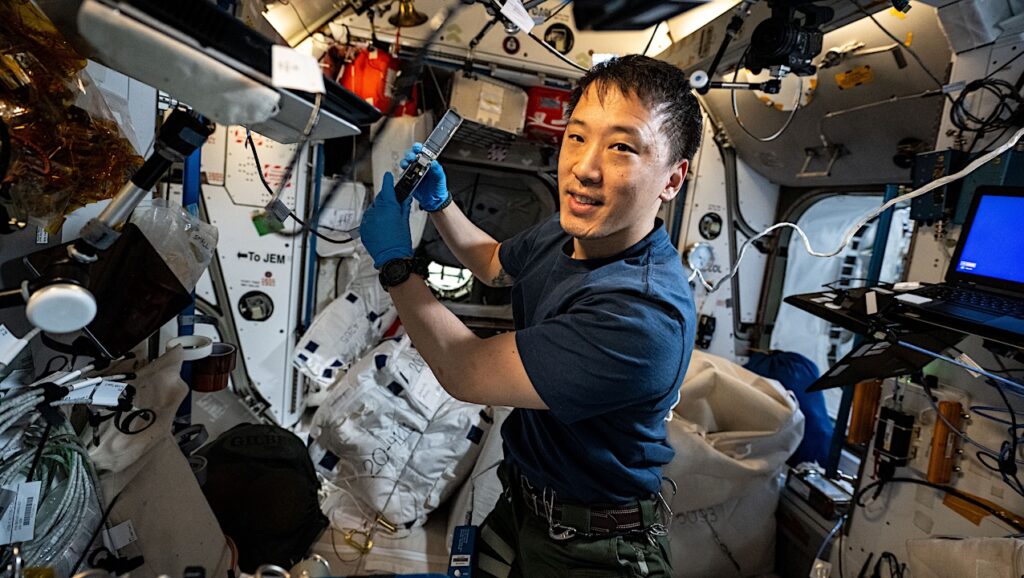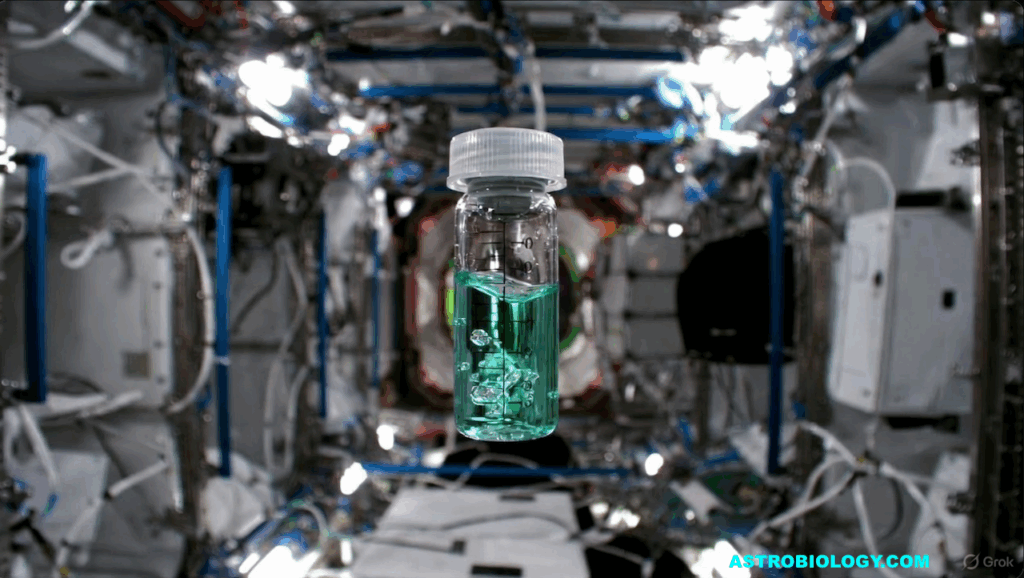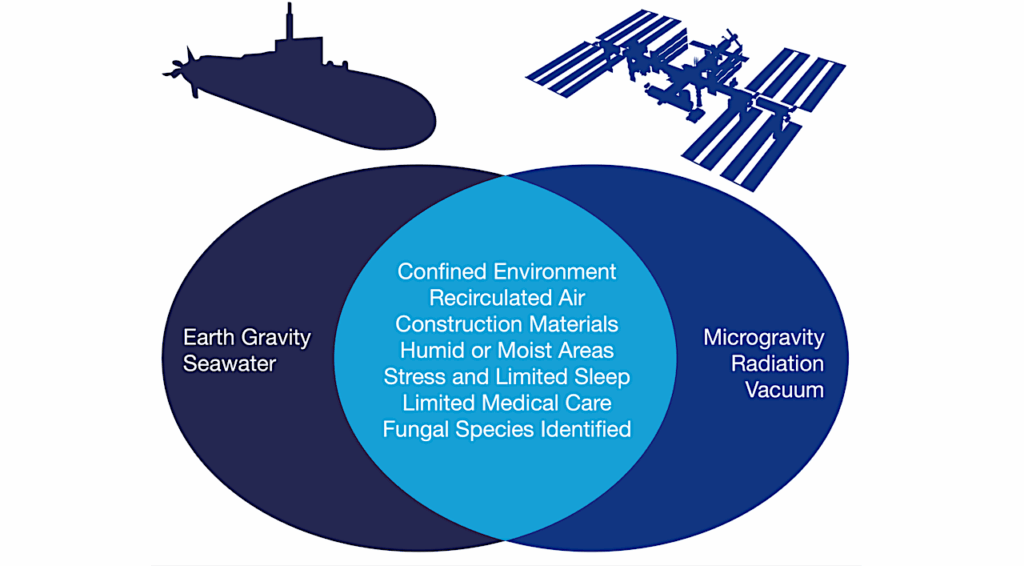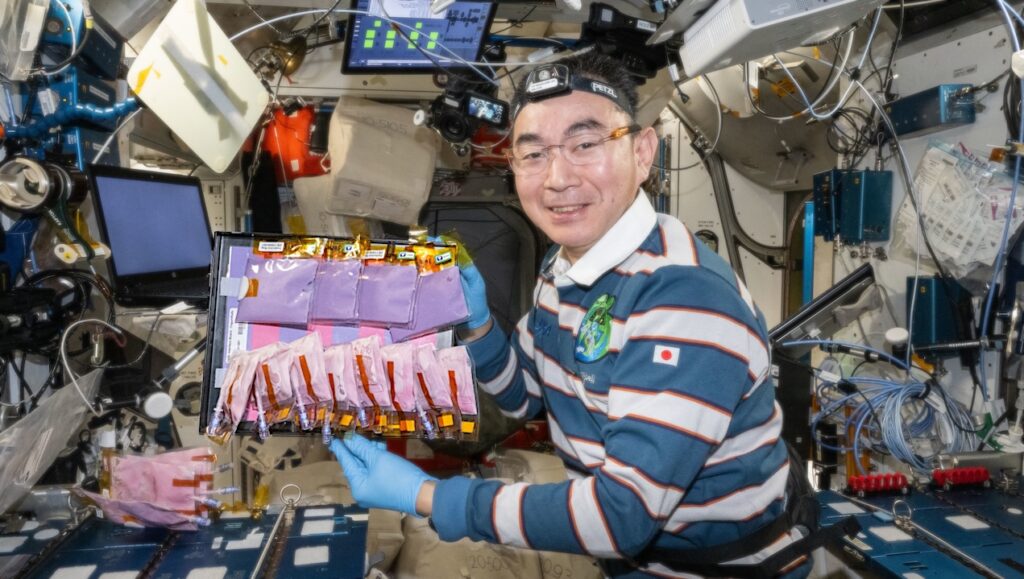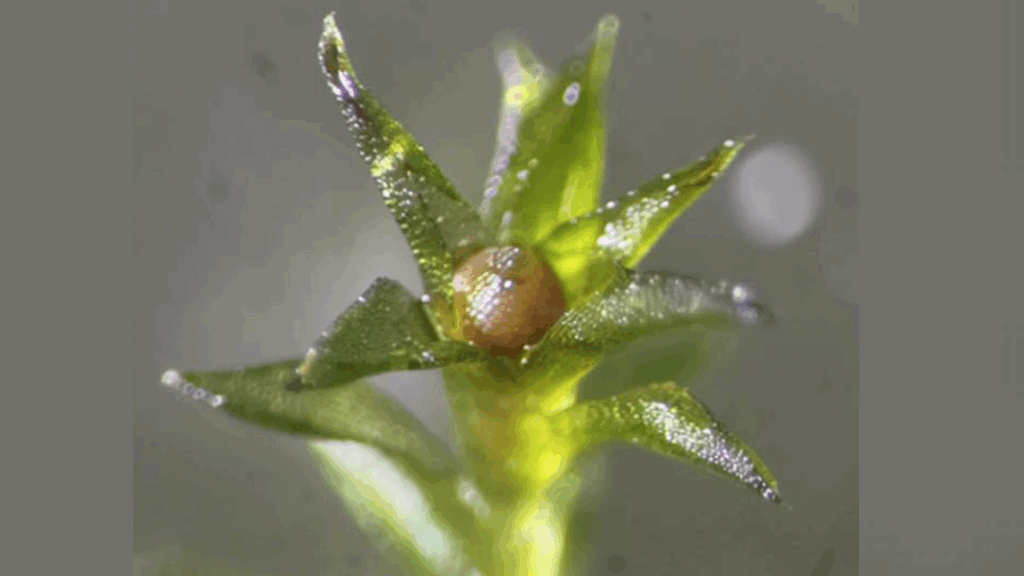NASA Spaceline Current Awareness List #1,077 – 1 December 2023 (Space Life Science Research Results)

Astronaut Thomas Pesquet works on the Cardinal Muscle investigation in the Life Sciences Glovebox aboard the International Space Station. Credits: NASA
SPACELINE Current Awareness Lists are distributed via listserv and are available on the NASA Task Book website at https://taskbook.nasaprs.com/Publication/spaceline.cfm. Please send any correspondence to Shawna Byrd, SPACELINE Current Awareness Senior Editor, [email protected].
Call for articles to cite in the weekly lists: Authors at NASA Centers and NASA PIs—do you have an article that has recently published or will publish in the upcoming weeks within a peer-reviewed journal and is in the scope of space life sciences? If so, send it our way! Send your article to the email address mentioned above. Articles received by Wednesday will appear within that week’s list—articles received after Wednesday will appear the following week.
Papers deriving from NASA support:
- Barcenilla BB, Meyers AD, Castillo-González C, Young P, Min JH, Song J, Phadke C, Land E, Canaday E, Perera IY, Bailey SM, Aquilano R, Wyatt SE, Shippen DE.Arabidopsis telomerase takes off by uncoupling enzyme activity from telomere length maintenance in space.Nat Commun. 2023 Nov 29;14:7854.Note: ISS results. This article may be obtained online without charge.
Journal Impact Factor: 16.6
Funding: “This work was supported by the National Institutes of Health (R01 GM065383 to D.E.S), the National Aeronautics and Space Administration (80NSSC19K1481 to S.E.W. and I.P; 80NSSC23K0302 to D.E.S, S.E.W., and S.M.B; and NNX14AH51G, NNX14AB01G, and 80NSSC19K0434 to S.M.B.) and the NASA Postdoctoral Program at Kennedy Space Center administered by Oak Ridge Associated Universities (to A.M.).” - Shavers MR, Semones EJ, Shurshakov V, Dobynde M, Sato T, Komiyama T, Tomi L, Chen J, El-Jaby S, Straube U, Li C, Rühm W.Comparison of dose and risk estimates between ISS partner agencies for a 30-day Lunar Mission.Z Med Phys. 2023 Nov 28:S0939-3889(23)00121-6. Online ahead of print.Note: From the abstract: “The International Partner Agencies of the International Space Station (ISS) present a comparison of the ionizing radiation absorbed dose and risk quantities used to characterize example missions in lunar space. This effort builds on previous collaborative work that characterizes radiation environments in space to support radiation protection for human spaceflight on ISS in low-Earth orbit (LEO) and exploration missions beyond (BLEO).”
Journal Impact Factor: 2
Funding: M.R. Shavers and E.J. Semones are affiliated with NASA Johnson Space Center. - Brent Woodland M, Ong J, Zaman N, Hirzallah M, Waisberg E, Masalkhi M, Kamran SA, Lee AG, Tavakkoli A.Applications of extended reality in spaceflight for human health and performance.Acta Astronaut. 2024 Jan;214:748-56.PI: A. TavakkoliNote: From the highlights: “This paper is intended to be a resource to update the medical community on the current and future integration of VR and AR into space exploration, particularly as this integration relates to astronaut health.”
Journal Impact Factor: 3.5
Funding: “NASA Grant [80NSSC20K183]: A Non-intrusive Ocular Monitoring Framework to Model Ocular Structure and Functional Changes due to Long-term Spaceflight.” - Chang AM, Anderson C, Cain SW, Reichenberger DA, Ronda JM, Lockley SW, Czeisler CA.Entrainment to gradual vs. immediate 8-hour phase advance shifts with and without short-wavelength enriched polychromatic green light.Sleep Health. 2023 Nov 20:S2352-7218(23)00227-9. Online ahead of print.PIs: S.W. Lockley, C.A. CzeislerNote: From the abstract: “For optimal health and well-being the sleep episode and the circadian timing system should be properly aligned. We evaluated the effectiveness of different dynamic light and sleep/wake shift schedules for rapid circadian entrainment following an 8-hour advance of sleep.”
Journal Impact Factor: 4.1
Funding: “This study was supported by the National Space Biomedical Research Institute (NSBRI) grant HFP01601 through NASA NCC 9-58. Inpatient studies were conducted in the CTSC and supported in part by UL1 RR025758 from the National Center for Research Resources (NCRR) of the National Institutes of Health (NIH). A-MC was supported in part by NIH grant K01HL115458.” - Clément G, Macaulay TR, Moudy SC, Kuldavletova O, Wood SJ.Back to the future—Revisiting Skylab data on ocular counter-rolling and motion sickness.Front Physiol. 2023 Nov 21;14:1303938.PI: S.J. WoodNote: This article and an article below (Pastushkova et al.) in the “Other” section are part of Research Topic “Space Physiology and Medicine: Reports and Unique Data Obtained on Small Sample Sizes” (https://www.frontiersin.org/research-topics/58257/space-physiology-and-medicine-reports-and-unique-data-obtained-on-small-sample-sizes#overview). Additional articles will be forthcoming and may be found in the link to the Research Topic. This article may be obtained online without charge.
Journal Impact Factor: 4.0
Funding: “The authors declare financial support was received for the research, authorship, and/or publication of this article. The National Aeronautics and Space Administration (NASA) provided funding for this study.” - Desai RI, Kangas BD, Luc OT, Solakidou E, Smith EC, Dawes MH, Ma X, Makriyannis A, Chatterjee S, Dayeh MA, Muñoz-Jaramillo A, Desai MI, Limoli CL.Complex 33-beam simulated galactic cosmic radiation exposure impacts cognitive function and prefrontal cortex neurotransmitter networks in male mice.Nat Commun. 2023 Nov 27;14(1):7779.PI: C.L. Limoli/NSCORNote: This article may be obtained online without charge.
Journal Impact Factor: 16.6
Funding: “This study was supported in part by National Aeronautics and Space Administration (NASA), NASA Johnson Space Center grant TXS0147017 (R.I.D.) and NASA NSCOR grant number NNX15AI22G (C.L.L.). M.A.D. Acknowledges support from the NASA SHIELD DRIVE Science Center in BU, grant 80NSSC20K0603.” - Meas SJ, Daire GM, Friedman MA, DeNapoli R, Ghosh P, Farr JN, Donahue HJ.A comparison of bone microarchitectural and transcriptomic changes in murine long bones in response to hindlimb unloading and aging.Bone. 2023 Nov 21;116973. Online ahead of print.PI: H.J. DonahueNote: Hindlimb unloading study.
Journal Impact Factor: 4.1
Funding: “This work was funded by NIH R01 AR068132, NASA 80NSSC18K1473, and CIHR DFSA 454761.”
Other papers of interest:
- Kemp TD, Besler BA, Gabel L, Boyd SK.Predicting bone adaptation in astronauts during and after spaceflight.Life (Basel). 2023 Nov 9;13(11):2183.Note: ISS results. This article is part of Special Issue “The Space Environment on Human Health and Disease” (https://www.mdpi.com/journal/life/special_issues/space_microbiome). The Special Issue also includes articles from previous Current Awareness Lists #997 https://doi.org/10.3390/life12040495; #1,011 https://doi.org/10.3390/life12071060 and https://doi.org/10.3390/life12081163; #1,015 https://doi.org/10.3390/life12091301; #1,026 https://doi.org/10.3390/life12111865; and #1,038 https://doi.org/10.3390/life13020588. Additional articles will be forthcoming and may be found in the link to the Special Issue. This article may be obtained online without charge.
- Burles F, Iaria G.Neurocognitive adaptations for spatial orientation and navigation in astronauts.Brain Sciences. 2023 Nov 15;13(11):1592.Note: This article is part of Special Issue “The Contribution of Internal and External Factors to Human Spatial Navigation” (https://www.mdpi.com/journal/brainsci/special_issues/Q0UXGQ914R) and may be obtained online without charge.
- Rajput S, Mayor I, Diamond M, Rosenberg M, Cole V, Bhakare N, Aziz O, Wilder AL.Medical ethics of long-duration spaceflight.npj Microgravity. 2023 Nov 28;9:85. Review.Note: This article may be obtained online without charge.
- Divya Harika P, Mehta KH, Pulluri SS, Rana P, Rajani H, Aiman A.Oral health in zero gravity: A comprehensive review of orofacial effects and countermeasures in spaceflights.Cureus. 2023 Nov 19;15(11):e49035. Review.Note: This article may be obtained online without charge.
- Masalkhi M, Ong J, Waisberg E, Lee AG.Ocular oxidative changes and antioxidant therapy during spaceflight.Eye. 2023 Nov 24. Online ahead of print.
- Pastushkova LH, Goncharova AG, Rusanov VB, Nosovsky AM, Kashirina DN, Popova OV, Larina IM.Correlation between proteome changes and synchrony of cardiac electrical excitation under 3-day dry immersion conditions.Front Physiol. 2023 Dec 1;14:1285802.Note: This article and an article above (Clément et al.) in the “NASA” section are part of Research Topic “Space Physiology and Medicine: Reports and Unique Data Obtained on Small Sample Sizes” (https://www.frontiersin.org/research-topics/58257/space-physiology-and-medicine-reports-and-unique-data-obtained-on-small-sample-sizes#overview). This article may be obtained online without charge.
- Cortés-Sánchez JL, Melnik D, Sandt V, Kahlert S, Marchal S, Johnson IRD, Calvaruso M, Liemersdorf C, Wuest SL, Grimm D, Krüger M.Fluid and bubble flow detach adherent cancer cells to form spheroids on a random positioning machine.Cells. 2023 Nov 20;12(22):2665.Note: This article is part of Special Issue “Cells in Space and on Earth” (https://www.mdpi.com/journal/cells/special_issues/GP50606408) and may be obtained online without charge.
- Elahi MM, Witt AN, Pryzdial ELG, McBeth PB.Thrombotic triad in microgravity.Thromb Res. 2023 Nov 20;233:82-7. Review.Note: From the abstract: “Thrombotic disease may be an underdiagnosed condition of prolonged exposure to microgravity and yet the underlying factors remain poorly defined. Recently, an internal jugular vein thrombosis was diagnosed in a low-risk female astronaut after an approximately 7-week space mission. Six of the additional 10 crewmembers demonstrated jugular venous flow risk factors, such as suspicious stagnation or retroversion. Fortunately, all were asymptomatic. Observations in space as well as clinical and in vitro microgravity studies on Earth, where experiments are designed to recapitulate the conditions of space, suggest effects on blood flow stasis, coagulation, and vascular function. In this article, the related literature on thrombotic disease in space is reviewed, with consideration of these elements of Virchow’s triad.”
- Warth N, Berg M, Schumacher L, Boehme M, Windisch J, Gelinsky M.Bioprint FirstAid: A handheld bioprinter for first aid utilization on space exploration missions.Acta Astronaut. 2023 Nov 26. Online ahead of print.Note: From the abstract: “Human exploratory missions to the Moon or Mars are considered the next steps in human space exploration. Such activities result in the long-term exposure of humans to the space environment, especially under the constraints of orbital dynamics as with increasing distances from Earth, quick return possibilities are ruled out. Crews on these kinds of missions must be self-sustaining in medical treatments, as environmental conditions in space, such as the influence of altered gravity, radiation or isolation, raise health issues. Therefore, astronauts may use the Handheld Bioprinter presented here as part of the first-aid strategy for in situ wound treatment.”
- Tu KJ, Stewart CE, Williams NT, Ma Y, Luo L, Ghosh D, Weidenhammer LB, Floyd SR, Fan Y, Kirsch DG, Oldham M, Reitman ZJ.Single-fraction radiation treatment dose response in a genetically engineered mouse model of medulloblastoma.Radiat Res. 2023 Nov 22. Online ahead of print.
- Wang VA, Leung M, Liu M, Modest AM, Hacker MR, Gupta M, Vieira CLZ, Weisskopf MG, Schwartz J, Coull BA, Papatheodorou S, Koutrakis P.Association between gestational exposure to solar activity and pregnancy loss using live births from a Massachusetts-based medical center.Environ Res. 20 Feb;242:2117742.Note: From the abstract: “Our study included 71,963 singleton births conceived in 2002-2016 and delivered at an academic medical center in Eastern Massachusetts. We studied several solar activity metrics, including sunspot number, Kp index, and ultraviolet radiation, with data from the NASA Goddard Space Flight Center and European Centre for Medium-Range Weather Forecasts. We used a novel time series analytic approach to investigate associations between each metric from conception through 24 weeks of gestation and the number of live birth-identified conceptions (LBICs)—the total number of conceptions in each week that result in a live birth. This approach fits distributed lag models to data on LBICs, adjusted for time trends, and allows us to infer associations between pregnancy exposure and pregnancy loss.”
- Hannemann J, Freytag J, Schiefer LM, Macholz F, Sareban M, Schmidt-Hutten L, Stang H, Schwedhelm E, Swenson ER, Böger R, Berger MM.Asymmetric and symmetric dimethylarginine in high altitude pulmonary hypertension (HAPH) and high altitude pulmonary edema (HAPE).Front Physiol. 2023 Nov 29;14:1297636.Note: This article may be obtained online without charge.
- Singh S, Singh N, Baranwal M, Sharma S, Devi SSK, Kumar S.Understanding immune checkpoints and PD-1/PD-L1-mediated immune resistance towards tumor immunotherapy.3 Biotech. 2023 Dec;13(12):411. Review.
- Pergande MR, Osterbauer KJ, Buck KM, Roberts DS, Wood NN, Balasubramanian P, Mann MW, Rossler KJ, Diffee GM, Colman RJ, Anderson RM, Ge Y.Mass spectrometry-based multiomics identifies metabolic signatures of sarcopenia in rhesus monkey skeletal muscle.J Proteome Res. 2023 Nov 22. Online ahead of print.
- Samoilenko T, Shishkina V, Antakova L, Goryushkina Y, Kostin A, Buchwalow I, Tiemann M, Atiakshin D.Smooth muscle actin as a criterion for gravisensitivity of stomach and jejunum in laboratory rodents.Int J Mol Sci. 2023 Nov 20;24(22):16539.Note: This article is part of Special Issue “Cellular and Molecular Signaling Meet the Space Environment 2.0” (https://www.mdpi.com/journal/ijms/special_issues/NG6NTA62OE). The Special Issue includes articles from Current Awareness lists #1,034 https://doi.org/10.3390/ijms24021540; #1,048 https://doi.org/10.3390/ijms24087656; #1,058 https://doi.org/10.3390/ijms241311135; #1,064 https://doi.org/10.3390/ijms241612640; #1,065 https://doi.org/10.3390/ijms241713569 and https://doi.org/10.3390/ijms241713604; and #1,074 https://doi.org/10.3390/ijms242115997. This article may be obtained online without charge.
- Shinohara I, Tsubosaka M, Toya M, Lee ML, Kushioka J, Murayama M, Gao Q, Li X, Zhang N, Chow SK, Matsumoto T, Kuroda R, Goodman SB.C-C motif chemokine ligand 2 enhances macrophage chemotaxis, osteogenesis, and angiogenesis during the inflammatory phase of bone regeneration.Biomolecules. 2023 Nov 18;13(11):1665.Note: This article is part of Special Issue “Regulation of Cytokine Signaling in Health and Disease” (https://www.mdpi.com/journal/biomolecules/special_issues/K5JY2TKTFB) and may be obtained online without charge.
- Li Y, Wang L, Chen Y, Zhang J, Xu W.Recovery of root hydrotropism in miz1 mutant by eliminating root gravitropism.J Plant Physiol. 2023 Nove 23;154144. Online ahead of print.


